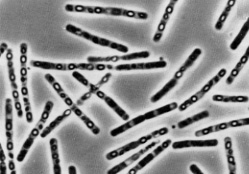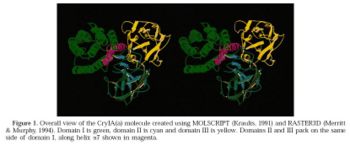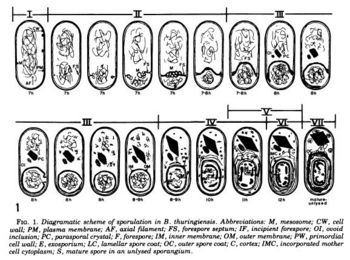Bacillus thuringiensis
A Microbial Biorealm page on the genus Bacillus thuringiensis

Classification
Higher order taxa
Eubacteria (kingdom); Bacteria (domain); Firmicutes (phylum); Bacilli (class); Bacillales (order); Bacillaceae (family); Bacillus (genus); Bacillus cereus group
Species
Bacillus thuringiensis
Description and significance
B. thuringiensis (Bt) is a gram positive, soil-dwelling, spore-forming, rod-shaped bacteria. It is approximately 1 µm in width and 5 µm in length.[3][11] It grows at body temperature and produces a diamond-shaped crystal from its crystal proteins (Cry proteins) and uses it to fend off insects, predators, and other pathogens.[2]

Its genome was recently sequenced (February 23rd, 2007) [11]. It is critical to have B. thuringiensis' genome sequenced because it has many benefits for humans in the form of agriculture. Bt is the most common environmentally-friendly insecticide used and is the basis of over 90% of the pesticides available in the market today.[1] Having sequenced the entire genome, scientists can witness and determine how mutations can create different variant strains that may eventually grow stronger against antibiotic pests. In 2005, over 26 million hectares of Bt-enduced transgenic corn and cotton were planted.[10] Many pests were exterminated because the Cry protein family has many flexible toxin variants. B. thuringiensis pesticide S-layer (where the Cry protein and toxins lie) has no known negative effects on humans, vertebrates, or plants.
Many studies indicate and consider B. thuringiensis and B. cereus to be one species. However, their phenotypes greatly differ in that Bt produces crystal proteins despite the fact that crystal protein synthesis are controlled by plasmid genes which can be susceptible to loss and transmission to related bacteria. One response is that Bt strains produce enterotoxins (toxins released by micro-organisms in the lower intestine) that are involved in B. cereus pathogenesis and therefore signifies a fine-line between the two species.[1]
Genome structure
B. thuringiensis has a circular chromosome and a GC-content of approximately 32%~35%. It has a genome size of between 5.2–5.8 Megabases.[11] It is a facultative anaerobic organism (an organism that makes ATP by aerobic respiration if oxygen is present but can also switch to fermentation). It has many plasmids and Bt's strains harbors a diverse range of plasmids that varies in number and in size (2–200kb).[14] The self-replicating plasmids are important to the organism's lineage and lifestyle.[11]
The largest class of genes consists of the "δ-endotoxins" (from the Cry proteins), which often are produced as 130–140 kDa protein precursors in the insect gut under high-pH conditions to yield a 60–65 kDa biologically active core toxin.[1] These δ-Endotoxins are frequently expressed in cotton, potatoes, rice and corn. These "δ-endotoxins" from the plasmids may be more than 50kb long and self-transmissible via a conjugation-like mechanism.[7]
Cell structure and metabolism
Describe any interesting features and/or cell structures; how it gains energy; what important molecules it produces.
Because B. thuringiensis is gram-positive, it also has a thick cell wall that is comprised of a peptidoglycan (amino acid polypeptide and a sugar). Between the cell wall and the plasma membrane is a small section called the periplasmic space which is essentail for biosynthesis and protection.
Most research has been focused on the Cry toxin crystals. Though they are many strains that differ in "insectisidal spectra and divergence in amino acid sequences"[20], the Cry proteins' activity is similar. The most salient Cry toxin and best studied is the CryI subclass. It is comprised of three distinct domains. Domain I (residues 33 to 253) contains eight alpha-helicies and no beta-sheets. Domain II (residues 265 to 461) contains three anti-parallel beta-sheets and two short alpha-helicies. Domain III (residues 463-609) contains a beta-sandwich of two anti-parallel beta-sheets.
The optimal condition for the Cry toxin to grow and sporulate is in the insect's alkaline gut.[20] This facilitates the ability to infect insect guts. The following is a summary of the life cycle of Bt. Stage I: axial filament formation; Stage II: forespore formation; Stage III: engulfment; Stage IV-VI: formation of cell wall, corex, and spore coats accompanied by transformation of the spore nucleeoid; Stage VII: spore maturation.[15]
Ecology
Describe any interactions with other organisms (included eukaryotes), contributions to the environment, effect on environment, etc.
Several studies have been done on animals to test the effects of B. thuringiensis. When treated with 10,000 mg of Bt per kg body weight, autopsy results on birds showed no pathology was attributed. High concentrations of Bt in fish and aquatic organisms failed to show any adverse effects . Experiments performed on other animals showed similar negative results. Conclusion: There seems to be no adverse effects on eukaryotic-celled organisms when exposed to Bt.[3]
Effects on the environment are largely considered mild. It is made from the soil and thrives at body temperature. When exposed to higher temperatures such as sunlight (UV light) however, its half-life greatly decreases to around 3.8 hours. As soon as it is exposed to a warmer-than-normal medium, B. thuringiensis' spores start deteriorating and loses viability within four days. Normally, a short half-life is bad. But in Bt's case, it is actually good in that the short half-life minimizes antibiotic resistance. An additional advantage of its rapid degradation stems from it being readily biodegradable. Possible future reseach in breaking down plastic bags? [4]
[attributed to what] [Bt is from soil]? "it is actually good in that..." good for us or them?
does NO harm to environment unlike chemicals n shit.
When field tests were performed on a sample of transgenic corn, reseraches discovered better protection from root damage by Western corn rootworm than by chemical pesticides.[7]
Pathology
Common insect targets are "moths, mosquitoes, blackflies, beetles, hoppers, aphids, wasps and bees as well as nematodes"[17][18][19]. The toxicity and virulence lies in the crystals. The virulence of the Cry toxins is mediated by a cadherin receptor (a class of transmembrane proteins that play important roles in cell adhesion), BT-R1, which has been identified gut of many pathogenistic larvae. Here is a rough process on how B. thuringiensis causes disease. (1). B. thuringiensis is digested and the toxins are mixed with the high pH (basic conditions) to bind specific receptors in the gut to attack the host insect. (2). This process punches holes in the gut-lining and thus, the insect becomes weak. (3). As the gut is continuing to break down, spores begin to germinate from the toxic crystals and other bacterial pathogens start to infect the host. (4). B. thuringiensis spores are continuously weakening the host and the insect dies soon thereafter.
The Bacillus thuringiensis toxin is species-specific and non-pathogenic to humans.[5] Specifically, however, Bt targets pests in the orders Lepidoptera, Coleptera, and Diptera.[18] The Cry crystal toxins contain proteins that are highly toxic towards invertebrates but nontoxic towards vertebrates.[8] There are different variant strains of B. thuringiensis Cry toxin that effect different hosts. Despite this variability, there is still a high degree of structural conservation among Cry toxin which suggests that "they possess a fundamental mechanism". All Cry variants follow a similar two-phase mechansim when infectin the host: (1). solubilization and proteolytic activatin the gut and (2) binding to the intestical cells with pore formation.[9]
Application to Biotechnology
Does this organism produce any useful compounds or enzymes? What are they and how are they used?
It was once thought that B. thuringiensis' method of toxology was via toxin-mediated disruption, which basically consisted of Bt killing the host by starvation or blood poison. However, recent reserach by scientists at the University of Wisconsin-Madison reported having other players involved.[5]
(Soil-transmitted nematode (STN) infections represent a major cause of morbidity in developing countries, with an estimated burden of human disease comparable with that of malaria or tuberculosis (1–3). In addition to human health, animal nematode infections are of major veterinary significance, resulting in millions of dollars of lost revenue for industries that provide products and food from livestock, including cattle and sheep (4–8). Although anti-nematode drugs (anthelminthics) exist, there are well founded concerns about the emergence of resistance to these compounds. Hence, there exists a pressing need to develop new, safe, and inexpensive agents for the treatment of human and veterinary nematode infections of global significance (8–12).)
underlined METHOD OF TOXOLOGY WAS VIA TOXIN-MEDIATED
Current Research
Enter summaries of the most recent research here--at least three required
1. http://www.bt.ucsd.edu/ http://biology.ucsd.edu/faculty/aroian.html
2. http://www.ncbi.nlm.nih.gov/entrez/query.fcgi?db=pubmed&cmd=Retrieve&dopt=AbstractPlus&list_uids=17461054&query_hl=1&itool=pubmed_docsum study on maize
3. Find out what Dr. Larsen's lab is doing.
References
National Center for Biotechnology Information
(1) http://textbookofbacteriology.net/Anthrax.html
(2) http://www.bact.wisc.edu/themicrobialworld/structure.html
(3) http://www.ncbi.nlm.nih.gov/entrez/query.fcgi?db=genome&cmd=Retrieve&dopt=Overview&list_uids=20524
(4) http://www.pubmedcentral.nih.gov/articlerender.fcgi?artid=232943&tools=bot
(5) http://www.bt.ucsd.edu/how_bt_work.html
(6) http://extoxnet.orst.edu/pips/bacillus.htm
(7) http://www.bt.ucsd.edu/what_is_bt.html
(8) http://www.ncbi.nlm.nih.gov/entrez/query.fcgi?db=genome&cmd=Retrieve&dopt=Overview&list_uids=20524
(10) http://www.mrc-lmb.cam.ac.uk/genomes/madanm/articles/dnashuff.htm
(11) http://www.ncbi.nlm.nih.gov/entrez/query.fcgi?db=genome&cmd=Retrieve&dopt=Overview&list_uids=20524
(12) http://pmep.cce.cornell.edu/profiles/extoxnet/24d-captan/bt-ext.html
(13) http://pmep.cce.cornell.edu/profiles/extoxnet/24d-captan/bt-ext.html
(14) http://microgen.ouhsc.edu/b_thuring/b_thuringiensis_home.htm
(15) http://pmep.cce.cornell.edu/profiles/extoxnet/24d-captan/bt-ext.html
(16) http://www.nanotechbuzz.com/50226711/bt_microbe_fools_biotech_experts.php
(17)
(18)
(19)
(20)
(21)
(22)
Edited by Ernest Hsu of Rachel Larsen and Kit Pogliano



